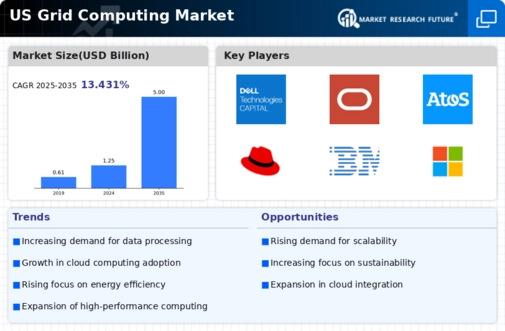Rising Demand for Data Processing
The grid computing market is experiencing a notable surge in demand for efficient data processing capabilities. As organizations increasingly rely on data-driven decision-making, the need for robust computing resources becomes paramount. In the US, the volume of data generated is projected to reach 175 zettabytes by 2025, necessitating advanced grid computing solutions. This trend indicates that businesses are seeking to leverage distributed computing to enhance their data processing capabilities, thereby driving growth in the grid computing market. Furthermore, the ability to process large datasets in real-time is becoming a competitive advantage, prompting companies to invest in grid computing technologies that can handle complex computations and analytics.
Cost Efficiency in IT Infrastructure
Cost efficiency remains a critical driver in the grid computing market. Organizations in the US are increasingly looking to optimize their IT infrastructure expenditures. By utilizing grid computing, companies can share resources across multiple systems, reducing the need for extensive hardware investments. This approach can lead to savings of up to 30% in operational costs, as resources are utilized more effectively. Additionally, the grid computing market enables businesses to scale their operations without incurring significant capital expenses. As organizations strive to maintain profitability while enhancing their technological capabilities, the cost-effectiveness of grid computing solutions is likely to propel market growth.
Advancements in Network Infrastructure
Advancements in network infrastructure are playing a pivotal role in the growth of the grid computing market. The increasing availability of high-speed internet and improved connectivity options are enabling organizations to leverage grid computing more effectively. In the US, the rollout of 5G technology is expected to enhance data transfer speeds and reduce latency, making grid computing solutions more viable for real-time applications. This technological evolution suggests that businesses will increasingly adopt grid computing to harness the benefits of enhanced network capabilities. As organizations seek to optimize their operations and improve service delivery, the grid computing market is likely to experience substantial growth.
Enhanced Collaboration Across Industries
The grid computing market is benefiting from enhanced collaboration across various industries. As sectors such as healthcare, finance, and research increasingly adopt collaborative models, the need for shared computing resources becomes evident. For instance, in the healthcare sector, grid computing facilitates the sharing of large datasets for research and patient care, improving outcomes and efficiency. This collaborative approach is expected to drive the grid computing market, as organizations recognize the value of pooling resources to tackle complex challenges. The potential for cross-industry partnerships may lead to innovative applications of grid computing, further expanding its reach and impact.
Growing Focus on Disaster Recovery Solutions
The grid computing market is witnessing a growing emphasis on disaster recovery solutions. Organizations in the US are increasingly aware of the risks associated with data loss and system failures. Grid computing offers a resilient framework for data backup and recovery, allowing businesses to maintain continuity in the face of disruptions. The market for disaster recovery solutions is projected to grow at a CAGR of 15% through 2025, indicating a strong demand for grid computing technologies that support these initiatives. By investing in grid computing, organizations can enhance their disaster recovery capabilities, ensuring that critical data and applications remain accessible even during adverse events.

















Leave a Comment